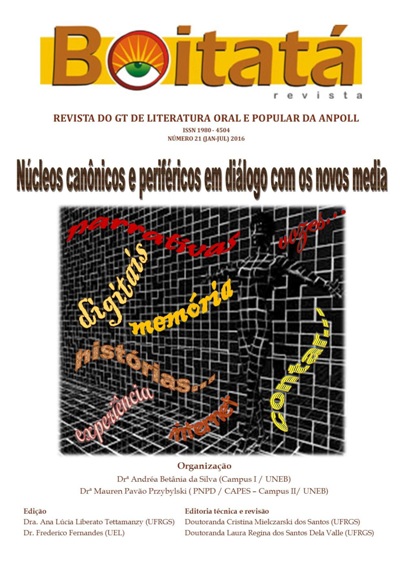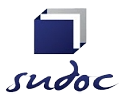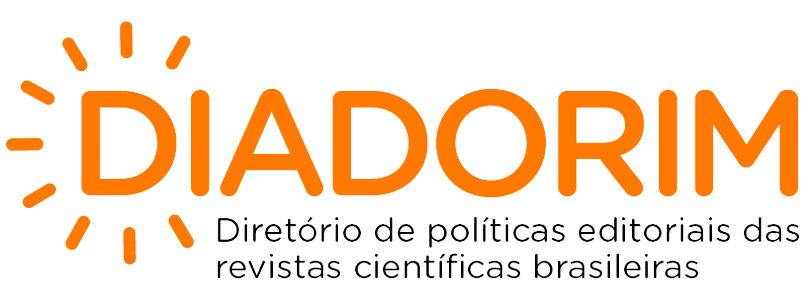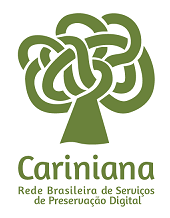Literary reimaginations distributed between paper and screen: the composition no.1 case
DOI:
https://doi.org/10.5433/boitata.2016v11.e31255Keywords:
Book, Print, Electronic Literature, Digital, Post-digita,Abstract
This article reflects on the novel Composition No.1 by Marc Saporta in its instantiation as a printed book and an iPad app. My aim is to understand how the transformation and transduction of Marc Saporta's text informs us about the contemporary textual and literary condition considering its print and electronic context. I propose that one of the current strategies in approaching the category of the book, and especially the narrative genre, is the feedback between digital and electronic processes as a way of intensification of the bibliographic aspects. At the same time, and because we are dealing with feedback loops processes, such exercises are, paradoxically, the reconceptualization of electronic literature itself within a logic and strategy characteristic of the post-digital.Downloads
Download data is not yet available.
References
AARSETH, Espen. Cybertext: perspectives on ergodic literature. Baltimore, MD: Johns Hopkins University Press, 1997.
ANDERSEN, Christian Ulrik, Soren Pold. Manifesto for a Post-Digital Interface. The new everyday. A media commons project. Special issue "The Operative Image." Ingrid Hoelzl (curadora). Out., 2014.
BAKHTIN, M.M. Dialogic imagination: four essays. Ed. Michael Holquist. Trans.Caryl Emerson e Michael Holquist. Texas: University of Texas Press,1981.
BOLTER, Jay David, Richard Grusin. Remediation: understanding new media. Cambridge, Mass.: The MIT Press, 2000.
BOOTZ, Phillipe. "Digital Poetry: From Cybertext to Programmed Forms." Leonardo Electronic Almanac "New Media Poetry and Poetics" Special Issue. 14 (5-6), 2006.
CRAMER, Florian. "Post-Digital Aesthetics." Jeu de Paume / Le Magazine. 5 jan. 2013.
CRAMER, Florian. 2014. "What Is 'Post-Digital'?" Aprja.net.
DRUCKER, Johanna. Entity to event: from literal, mechanistic materiality to probabilistic materiality. Parallax 15 (4), p. 7-17, 2009.
EMERSON, Lori. Reading writing interfaces: from the digital to the bookbound. Minneapolis: Univ Of Minnesota Press, 2014.
ESKELINEN, Markku. Cybertext poetics: the critical landscape of new media literary theory. New York: Bloomsbury Academic, 2012.
FLUSSER, Vilém. Ensaio sobre a fotografia: para uma filosofia da técnica. Mediações. Lisboa: Relógio d'Água, 1998.
FUNKHOUSER, C.T. Poetic mouldings on the Web. In: New directions in digital poetry, p. 1- 22. London: Continuum, 2012.
GUMBRECHT, Hans. Production of presence: what meaning cannot convey. Stanford, Calif: Stanford University Press, 2003.
HAYLES, N. Katherine, Anne Burdick. Writing machines. Cambridge, Mass: The MIT Press, 2002.
PLAZA, Julio. O Livro Como Forma de Arte. In: Perspectivas Do Livro de Artista, 2009.
PORTELA, Manuel. Scripting reading motions: the codex and the computer as self-reflexive machines. Cambridge, Massachusetts: The MIT Press, 2013.
PRESSMAN, Jessica. Digital modernism: making it new in new media. New York: Oxford University Press, 2014.
RECKWITZ, Andreas. The status of the 'Material' in theories of culture: from 'Social Structure' to 'Artefacts'. In: Journal for the Theory of Social Behaviour 32 (2), 195-217, 2002.
RETTBERG, Jill Walker. "Composition No. 1." ELMCIP, 2014. Disponível em: . Acesso em: 10 ago. 2014.
THOMPSON, Simon. Composition No.1 (Apple App) (version 1.0). Visual Editions, 2011.
ANDERSEN, Christian Ulrik, Soren Pold. Manifesto for a Post-Digital Interface. The new everyday. A media commons project. Special issue "The Operative Image." Ingrid Hoelzl (curadora). Out., 2014.
BAKHTIN, M.M. Dialogic imagination: four essays. Ed. Michael Holquist. Trans.Caryl Emerson e Michael Holquist. Texas: University of Texas Press,1981.
BOLTER, Jay David, Richard Grusin. Remediation: understanding new media. Cambridge, Mass.: The MIT Press, 2000.
BOOTZ, Phillipe. "Digital Poetry: From Cybertext to Programmed Forms." Leonardo Electronic Almanac "New Media Poetry and Poetics" Special Issue. 14 (5-6), 2006.
CRAMER, Florian. "Post-Digital Aesthetics." Jeu de Paume / Le Magazine. 5 jan. 2013.
CRAMER, Florian. 2014. "What Is 'Post-Digital'?" Aprja.net.
DRUCKER, Johanna. Entity to event: from literal, mechanistic materiality to probabilistic materiality. Parallax 15 (4), p. 7-17, 2009.
EMERSON, Lori. Reading writing interfaces: from the digital to the bookbound. Minneapolis: Univ Of Minnesota Press, 2014.
ESKELINEN, Markku. Cybertext poetics: the critical landscape of new media literary theory. New York: Bloomsbury Academic, 2012.
FLUSSER, Vilém. Ensaio sobre a fotografia: para uma filosofia da técnica. Mediações. Lisboa: Relógio d'Água, 1998.
FUNKHOUSER, C.T. Poetic mouldings on the Web. In: New directions in digital poetry, p. 1- 22. London: Continuum, 2012.
GUMBRECHT, Hans. Production of presence: what meaning cannot convey. Stanford, Calif: Stanford University Press, 2003.
HAYLES, N. Katherine, Anne Burdick. Writing machines. Cambridge, Mass: The MIT Press, 2002.
PLAZA, Julio. O Livro Como Forma de Arte. In: Perspectivas Do Livro de Artista, 2009.
PORTELA, Manuel. Scripting reading motions: the codex and the computer as self-reflexive machines. Cambridge, Massachusetts: The MIT Press, 2013.
PRESSMAN, Jessica. Digital modernism: making it new in new media. New York: Oxford University Press, 2014.
RECKWITZ, Andreas. The status of the 'Material' in theories of culture: from 'Social Structure' to 'Artefacts'. In: Journal for the Theory of Social Behaviour 32 (2), 195-217, 2002.
RETTBERG, Jill Walker. "Composition No. 1." ELMCIP, 2014. Disponível em: . Acesso em: 10 ago. 2014.
THOMPSON, Simon. Composition No.1 (Apple App) (version 1.0). Visual Editions, 2011.
Downloads
Published
2016-12-11
How to Cite
BETTENCOURT, Sandra. Literary reimaginations distributed between paper and screen: the composition no.1 case. Boitatá, Londrina, v. 11, n. 21, p. 82–99, 2016. DOI: 10.5433/boitata.2016v11.e31255. Disponível em: https://ojs.uel.br/revistas/uel/index.php/boitata/article/view/31255. Acesso em: 25 dec. 2025.
Issue
Section
Dossiê
License
Copyright (c) 2016 Boitatá

This work is licensed under a Creative Commons Attribution 4.0 International License.
Boitatá esta licenciada com CC BY sob essa licença é possível: Compartilhar - copiar e redistribuir o material em qualquer suporte ou formato. Adaptar - remixar, transformar, e criar a partir do material, atribuindo o devido crédito e prover um link para a licença e indicar se mudanças foram feitas.






















